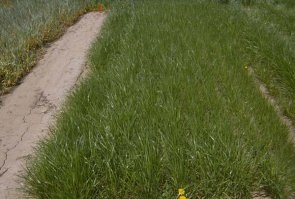Ryegrass
Information on the benefits and growth habits of ryegrass planted as a cover crop.
Description
Family
- Grass.
- Perennial, annual or Italian ryegrass.
Growth habits
Germination
- Annual ryegrass is prone to reseeding.
- Perennial ryegrass is slow to establish with lower seedling vigour than annual ryegrass.
Top growth
- Shade tolerant, often used in orchards and vineyards for ground cover.
- Annual ryegrass grows 60 to 120 cm.
- Perennial ryegrass will grow 30 to 90 cm annually for 3–4 years and is competitive and aggressive when established.
- Generally performs poorly in warm temperatures, dry soils and poor fertility.
Root system
- Dense, fibrous root system that roots deeply.
Site suitability
- Annual ryegrass tolerates more standing water than perennial ryegrass.
- Grows best on medium to heavy soils.
- High requirements for moisture and nutrients.
Control options
- Tillage and herbicide burndown.
Sensitivity to herbicides: Weed control
- There are no herbicides registered for weed control in ryegrass. Use good agronomic practices to establish a vigorous crop canopy as quickly as possible.
Benefits and concerns
Nutrient management
- Heavy nitrogen feeder when established.
- Wide C:N ratio of residue means N will not be released quickly.
Pest management
- Rapid and aggressive growth will suppress weeds.
Organic matter
- Forms a dense sod and lumpy seedbed — can cause some problems with establishment of subsequent crop.
Erosion control
- Used for permaculture areas as erosion control and weed control measure.
Soil moisture
- Tolerant of high soil moisture conditions.
Getting started
Establishment
- Fine firm seedbed needed.
Cost and availability
- Seed readily available.
- Perennial more expensive than annual ryegrass.
- Cost can be variety dependent; low growing turf hybrids are more expensive.
Updated: January 14, 2025
Published: August 24, 2022
